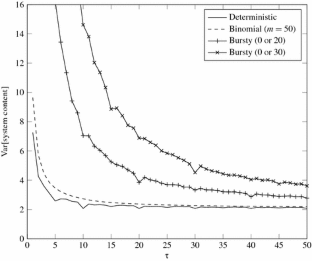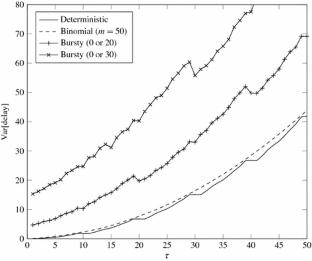Abstract
In this paper, we study a non-classical discrete-time queueing model with variable service demands and variable service capacities. Specifically, we consider the case where the service capacities of the system, i.e., the numbers of work units that the system can perform during each slot, are independent from slot to slot and have an identical general distribution with finite support. New customers enter the system according to a general independent arrival process. The service demands of the customers, i.e., the numbers of work units of service that each customer requires from the system, are general independent. We present an analytical technique to analyze the behavior of this queueing system. The analysis leads to expressions for the probability generating functions and the moments of the unfinished work in the system, the queueing delay of an arbitrary customer and the number of customers in the system in steady state. We also derive approximations for the tail probabilities of the system content and the customer delay. Numerical results are included to illustrate the impact of the various model parameters on the system performance.








Similar content being viewed by others
Notes
Busy periods are defined as usual, with one special case: If a customer finishes service with no other customers in the queue except customers that arrived during that slot, then any remaining service capacity can’t be used on these arriving customers. In that case, we consider the busy period to end during this slot and a new busy period to begin in the next slot, with no idle period in between.
Except for those z for which the characteristic equation has no roots at all, i.e., \(z=0\) and \(A(z)=0\) for the \(x_p\)’s and \(y_p\)’s respectively. But in those cases we already know that \(D(z)=0\) and \(B(z)=0\) respectively, as discussed earlier.
References
Abate, J., & Whitt, W. (1992). Numerical inversion of probability generating functions. Operations Research Letters, 12, 245–251.
Ayed, S., Dellagi, S., & Rezg, N. (2011). Optimal integrated maintenance production strategy with variable production rate for random demand and subcontracting constraint. In Proceedings of the 18th IFAC world congress.
Bruneel, H. (1984). A general model for the behaviour of infinite buffers with periodic service opportunities. European Journal of Operational Research, 16(1), 98–106.
Bruneel, H., & Kim, B. G. (1993). Discrete-time models for communication systems including ATM. Boston: Kluwer Academic.
Bruneel, H., Rogiest, W., Walraevens, J., & Wittevrongel, S. (2014). On queues with general service demands and constant service capacity. In Proceedings of the 11th international conference on quantitative evaluation of SysTems, QEST 2014, Florence, Lecture notes in computer science (Vol. 8657, pp. 210–225). 8–10 September 2014
Bruneel, H., Walraevens, J., Claeys, D., & Wittevrongel, S. (2012). Analysis of a discrete-time queue with geometrically distributed service capacities. In Proceedings of the 19th international conference on analytical and stochastic modelling techniques and applications, ASMTA 2012, Grenoble. Lecture notes in computer science (Vol. 7314, pp. 121–135), 4–6 June 2012
Chakravarthy, S. R. (2009). Analysis of a multi-server queue with Markovian arrivals and synchronous phase type vacations. Asia-Pacific Journal of Operational Research, 26(1), 85–113.
Dong, M., & Hou, F. (2012). Modelling and implementation of manufacturing direct labour allocation: A case study in semiconductor production operations. International Journal of Production Research, 50(4), 1029–1044.
Gao, P., Wittevrongel, S., Laevens, K., De Vleeschauwer, D., & Bruneel, H. (2010). Distributional Little’s law for queues with heterogeneous server interruptions. Electronics Letters, 46(11), 763–764.
Giri, B. C., Yun, W. Y., & Dohi, T. (2005). Optimal design of unreliable production inventory systems with variable production rate. European Journal of Operational Research, 162(2), 372–386.
Glock, C. H. (2010). Batch sizing with controllable production rates. International Journal of Production Research, 48, 5925–5942.
Hwang, Z., Kim, J., & Rhee, S. (2005). Development of a new highway capacity estimation method. In Proceedings of the Eastern Asia society for transportation studies (pp. 984–995).
Kleinrock, L. (1975). Queueing systems, volume I: Theory. New York: Wiley.
Krishnamoorthy, A., Pramod, P. K., & Chakravarthy, S. R. (2014). Queues with interruptions: A survey. TOP, 22(1), 290–320.
Laevens, K., & Bruneel, H. (1995). Delay analysis for discrete-time queueing systems with multiple randomly interrupted servers. European Journal of Operations Research, 85(1), 161–177.
Mitrani, I. (1987). Modelling of computer and communication systems. Cambridge: Cambridge University Press.
Morris, B., Notley, S., Boddington, K., & Rees, T. (2011). External factors affecting motorway capacity. Procedia Social and Behavioral Sciences, 16, 69–75.
Shahnazari-Shahrezaei, P., Tavakkoli-Moghaddam, R., Azarkish, M., & Sadeghnejad-Barkousaraie, A. (2012). A differential evolution algorithm for a nurse scheduling problem. South African Journal of Industrial Engineering, 23(3), 68–90.
Takagi, H. (1993). Queueing analysis—A foundation of performance evaluation, volume 3: Discrete-time systems. Amsterdam: North-Holland.
Walraevens, J., Bruneel, H., Claeys, D., & Wittevrongel, S. (2013). The discrete-time queue with geometrically distributed service capacities revisited. In Proceedings of the 20th international conference on analytical and stochastic modelling techniques and applications, ASMTA 2013, Ghent. Lecture Notes in Computer Science (Vol. 7984, pp. 443–456). 8–10 July 2013
Yang, X. L., & Alfa, A. S. (2009). A class of multi-server queueing system with server failures. Computers & Industrial Engineering, 56(1), 33–43.
Zied, H., Sofiene, D., & Nidhal, R. (2009). An optimal production/maintenance planning under stochastic random demand, service level and failure rate. In Proceedings of the IEEE international conference on automation science and engineering (CASE 2009) (pp. 292–297).
Acknowledgments
This research has been partly funded by the Interuniversity Attraction Poles Programme initiated by the Belgian Science Policy Office.
Author information
Authors and Affiliations
Corresponding author
Appendix: Multiple roots of the characteristic equations
Appendix: Multiple roots of the characteristic equations
In our analysis we have made the assumption that the characteristic equations \(1-zR(x)=0\) and \(1-A(z)R(y) = 0\) have m distinct roots for x and y in terms of z, which we denoted as \(x_p(z)\) and \(y_p(z)\) respectively. For the roots \(x_p(z)\) of (19) it is easily shown, similar to Laevens and Bruneel (1995), that for at most \(m-1\) values of z some of these roots can be identical. Indeed, a root of (19) with multiplicity larger than 1 must also satisfy the equation \(R'(x)=0\), which has at most \(m-1\) solutions for x, with at most \(m-1\) corresponding values for z from the characteristic equation (19). By a similar reasoning, it then follows that for at most \(m-1\) values of A(z) some of the roots \(y_p(z)\) of (34) can be identical. The number of z for which the roots of (34) are not distinct can however be infinite, if A(z) is not a polynomial.
In case some of the \(x_p\)’s or \(y_p\)’s are not distinct for some value of z, the expressions (21) for D(z) or (32) for B(z), respectively, are no longer valid. In particular, if such could occur for \(z=1\), our expressions for the mean delay or the mean system content would be invalidated.
In this “Appendix”, we indicate several possible ways to deal with this problem. Let us focus first on B(z) and let \(z^*\) be such a value of z for which some of the roots of (34) have a multiplicity larger than 1.
1.1 Exact calculation
In order to calculate the value of B(z) or any of its derivatives at \(z=z^*\) exactly, the partial fraction expansion (18) with z replaced by A(z) needs to be altered to account for the multiple roots. The rest of the steps in this paper can theoretically still be followed, but the analysis becomes more and more difficult as the multiplicity of the roots increases.
1.2 Approximation
It is much easier to approximate these values instead. Since B(z) must be a continuous function in its region of convergence, for every error term \(\epsilon \) there exists a \(\delta \) such that \(|z - z^*| < \delta \) implies that \(|B(z) - B(z^*)| < \epsilon \). This means that \(B(z^*)\) can be approximated with arbitrary precision by simply evaluating B(z) where z is “close enough” to \(z^*\).
Of course, if we wish to evaluate B(z) for such z close to \(z^*\) by using our expression (32), the roots \(y_p(z)\) must all be distinct. Luckily, if z is close enough to \(z^*\) this will not be a problem, because we can prove that for every \(z^*\) there exists a \(\gamma \) such that if \(0 < |z-z^*| < \gamma \) then the roots \(x_p(z)\) and \(y_p(z)\) are distinct. For the \(x_p(z)\)’s this is trivial since there are at most \(m-1\) values of z for which the \(x_p(z)\)’s are not all distinct. For the \(y_p(z)\)’s, we know that \(A(z^*)\) can take at most \(m-1\) distinct values. Since A(z) is analytic and non-constant (if A(z) is constant, i.e., \(A(z)=1\), then there are never any arrivals) in its region of convergence, for every \(\alpha \) there exists a \(\beta \) such that \(0 < |z-z^*| < \beta \) implies \(0 < |A(z) - A(z^*)| < \alpha \). Taking \(\alpha \) as the smallest distance between the possible values for \(A(z^*)\) therefore implies there exists a \(\beta \) such that \(A(z) \ne A(z^*)\) for any \(z^*\), which in turn implies that the roots \(y_p(z)\) are distinct.
In conclusion, \(B(z^*)\) can be approximated arbitrarily precisely without problems caused by multiple roots of the characteristic equation (34) by evaluation of B(z) where z is “close enough” to \(z^*\) (distance smaller than \(\delta \), \(\gamma \) and \(\beta \) above). Similar techniques can be applied to D(z) and all derivatives of B(z) and D(z).
1.3 Special case: Binomial service capacities
Neither of the above techniques are very appealing, since exact calculation is very difficult and the approximation might suffer from numerical stability issues if \(\delta \), \(\gamma \) or \(\beta \) is too small. Luckily, there is a broad class of service-capacity distributions for which the zeros \(x_p(z)\) and \(y_p(z)\) are always distinct for allFootnote 2 z, and can in fact be calculated explicitly, leading to closed-form expressions for B(z) and D(z). This is the case when R(z) has period \(c \ge 1\) and the service capacity in each slot divided by c follows a binomial distribution, i.e., when the pgf R(z) is given by
This class of distributions includes the Bernoulli distribution (\(m=c=1\)), the binomial distribution (\(c=1\)), the deterministic distribution (\(\mu = m\)) and the bursty distribution described in Sect. 10.2 (\(m=c\)). For these R(z), the zeros \(y_{kc+\ell }\), \(0 \le k < m/c\), \(0 \le \ell < c\), are given by the \(\ell \)-th complex c-th order root of \(1 - \frac{m}{\mu } + \frac{m}{\mu }w_k\), where \(w_k\) is the k-th complex m / c-th order root of 1 / A(z). With some abuse of notation, one could write
It is easily verified that these zeros are indeed distinct.
Rights and permissions
About this article
Cite this article
De Muynck, M., Wittevrongel, S. & Bruneel, H. Analysis of discrete-time queues with general service demands and finite-support service capacities. Ann Oper Res 252, 3–28 (2017). https://doi.org/10.1007/s10479-015-2060-9
Published:
Issue Date:
DOI: https://doi.org/10.1007/s10479-015-2060-9


